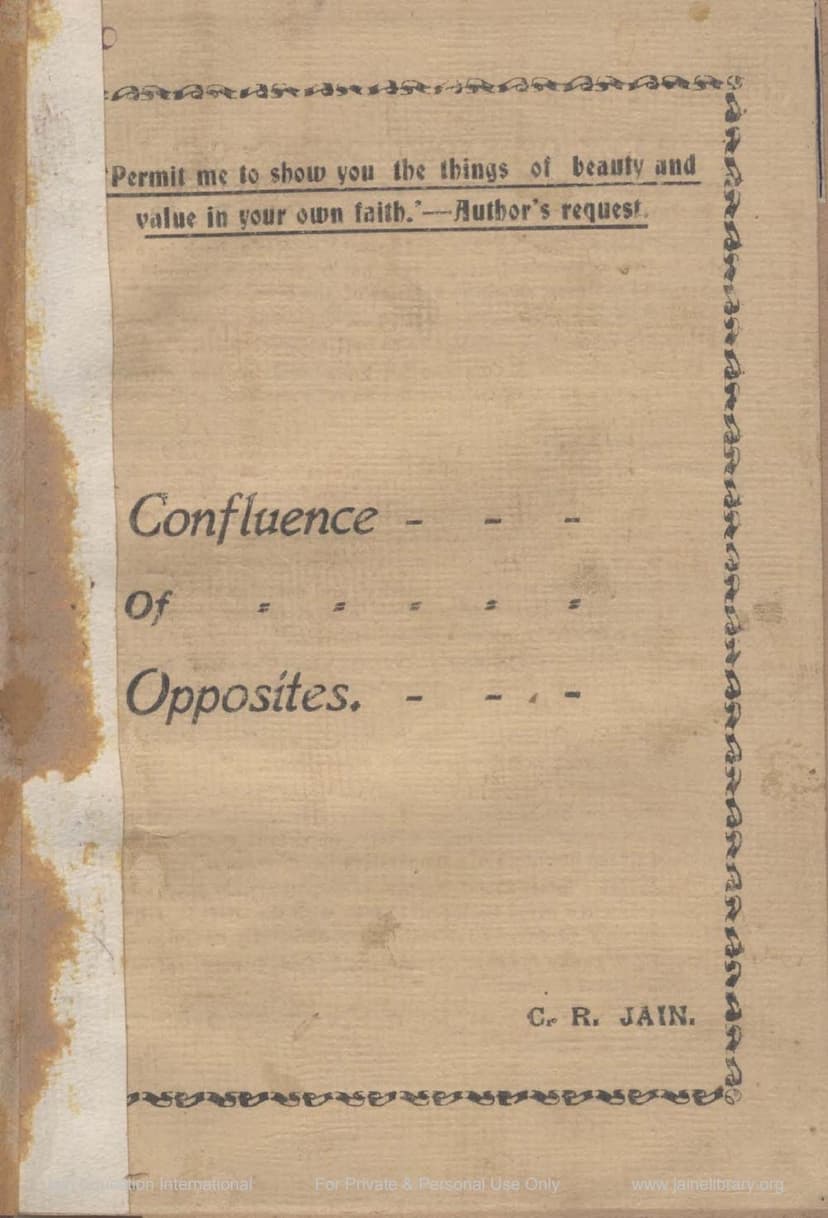Confluence Of Opposites
Added to library: September 1, 2025

Summary
Champat Rai Jain's "Confluence of Opposites; or Comparative Religion" is a profound exploration of various world religions and philosophical systems, aiming to reconcile their seemingly disparate teachings through a rational and scientific lens. The book, presented as a series of lectures, posits a groundbreaking discovery: a "secret language" or "Pictokrit" underlying all ancient scriptures, which, when deciphered, reveals a unified underlying truth.
The author begins by establishing comparative religion as a science, emphasizing the need for an unbiased, rational approach, free from superstition and dogma. He critiques traditional methods of reconciliation that merely highlight superficial similarities while ignoring fundamental differences. Jain argues that true reconciliation requires a deep analysis of these differences to uncover their common origin and unifying principles.
Key Themes and Arguments:
- The Science of Religion: Jain asserts that religion, when approached scientifically, can be understood through observation, inference, and (qualified) testimony. He champions logic and reason as the primary tools for understanding religious and philosophical truths, advocating for a critical yet constructive approach.
- The "Pictokrit" Language: A central thesis is the existence of a universal, secret symbolic language ("Pictokrit") embedded within all ancient scriptures, including the Vedas, Quran, and Bible. This symbolic layer, distinct from the literal text, holds the key to understanding the shared wisdom of different faiths.
- Reinterpreting Mythology: Jain systematically deconstructs the myths and narratives of various religions, arguing that they are not literal historical accounts but allegorical representations of profound spiritual and psychological truths. He analyzes figures like Agni, Indra, Surya in Vedic tradition, the God of Judaism, the Trinity in Christianity, and the deities of Islam, reinterpreting them as symbolic expressions of the soul's journey, the nature of consciousness, and the path to liberation.
- Jainism as a Scientific Foundation: The author positions Jainism as a scientific religion, providing the framework for understanding other traditions. He highlights Jain tenets like the seven tattvas, the concept of karma, and the path of Right Faith, Right Knowledge, and Right Conduct (the Triple Jewel) as foundational to spiritual progress.
- Critique of Materialism and Literalism: Jain critiques materialistic philosophies that deny the existence of the soul or attribute consciousness solely to the brain. He also challenges literal interpretations of religious texts, arguing that they lead to contradictions and misunderstandings, obscuring the deeper, symbolic meaning.
- The Soul's Divinity and Immortality: A recurring theme is the inherent divinity and potential omniscience of the soul. Jain argues that the soul, being an eternal and indivisible substance, is naturally divine. Its perceived limitations are due to the obscuring influence of matter and karmic forces.
- The Path to Liberation (Moksha/Nirvana): The book consistently points towards a path of self-realization, achieved through rigorous ethical discipline, asceticism (tapas), the subjugation of desires (raga and dvesha), and the cultivation of self-knowledge. This path is presented as universal, regardless of the specific religious tradition.
- Comparative Analysis of Religions: Jain dedicates extensive chapters to comparing and contrasting the doctrines and mythologies of various religions, including Vedicism, Zoroastrianism, Judaism, Christianity, Islam, Buddhism, Taoism, and various ancient cults. He systematically demonstrates parallels and underlying commonalities, arguing that apparent contradictions often arise from misinterpretations of symbolic language.
- The True Nature of God: The concept of God is re-examined, moving away from anthropomorphic creator deities towards the idea of an inherent, immanent divinity within the soul. The "I AM" of various traditions and the concept of the Tirthamkaras as perfected souls serve as examples of this universal Divine Principle.
- Ritual and Practice: The book delves into the symbolic meanings of rituals like prayer, sacrifice, and pilgrimage, arguing that their true efficacy lies not in external acts but in the internal transformation and spiritual discipline they represent.
In essence, "Confluence of Opposites" is a comprehensive and compelling argument for the underlying unity of all religions and philosophical systems, revealed through a scientific and rational interpretation of their sacred texts and mythologies. Jain's work aims to bridge divides, promote understanding, and present a unified vision of truth accessible to all humanity.